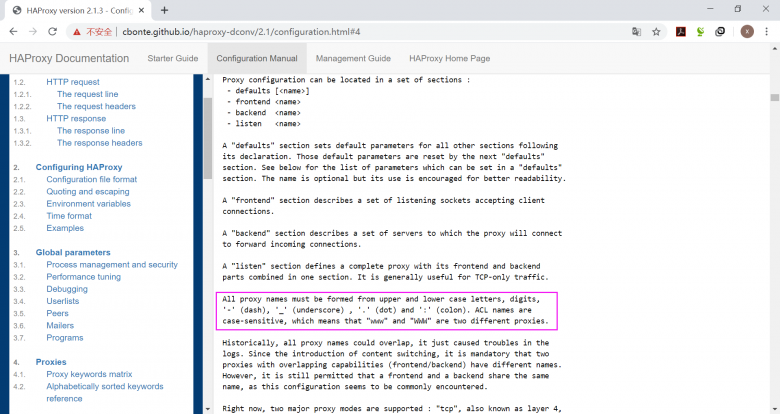Proxies配置
官方文档:http://cbonte.github.io/haproxy-dconv/2.1/configuration.html#4
defaults [<name>] #默认配置项,针对以下的frontend、backend和listen生效,可以多个name也可以没有name
frontend <name> #前端servername,类似于Nginx的一个虚拟主机 server和LVS服务集群。
backend <name> #后端服务器组,等于nginx的upstream和LVS中的RS服务器
listen <name> #将frontend和backend合并在一起配置,相对于frontend和backend配置更简洁,生产常用注意:name字段只能使用大小写字母,数字,‘-’(dash),’_‘(underscore),’.’ (dot)和 ‘:'(colon),并且严格区分大小写

Proxies配置-defaults
defaults 配置参数:
option redispatch #当server Id对应的服务器挂掉后,强制定向到其他健康的服务器,重新派发
option abortonclose #当服务器负载很高时,自动结束掉当前队列处理比较久的链接,针对业务情况选择开启
option http-keep-alive #开启与客户端的会话保持
option forwardfor #透传客户端真实IP至后端web服务器
mode http|tcp #设置默认工作类型,使用TCP服务器性能更好,减少压力
timeout http-keep-alive 120s #session 会话保持超时时间,此时间段内会转发到相同的后端服务器
timeout connect 120s #客户端请求从haproxy到后端server最长连接等待时间(TCP连接之前),默认单位ms
timeout server 600s #客户端请求从haproxy到后端服务端的请求处理超时时长(TCP连接之后),默认单位ms,如果超时,会出现502错误,此值建议设置较大些,访止502错误
timeout client 600s #设置haproxy与客户端的最长非活动时间,默认单位ms,建议和timeout server相同
timeout check 5s #对后端服务器的默认检测超时时间
default-server inter 1000 weight 3 #指定后端服务器的默认设置Proxies配置-frontend
frontend 配置参数:
bind: #指定HAProxy的监听地址,可以是IPV4或IPV6,可以同时监听多个IP或端口,可同时用于listen字段中
#格式:
bind [<address>]:<port_range> [, ...] [param*]
#注意:如果需要绑定在非本机的IP,需要开启内核参数:net.ipv4.ip_nonlocal_bind=1范例:
listen http_proxy #监听http的多个IP的多个端口和sock文件
bind :80,:443,:8801-8810
bind 10.0.0.1:10080,10.0.0.1:10443
bind /var/run/ssl-frontend.sock user root mode 600 accept-proxy
listen http_https_proxy #https监听
bind :80
bind :443 ssl crt /etc/haproxy/site.pem #公钥和私钥公共文件
listen http_https_proxy_explicit #监听ipv6、ipv4和unix sock文件
bind ipv6@:80
bind ipv4@public_ssl:443 ssl crt /etc/haproxy/site.pem
bind unix@ssl-frontend.sock user root mode 600 accept-proxy
listen external_bind_app1 #监听file descriptor
bind "fd@${FD_APP1}"生产示例:
frontend magedu_web_port #可以采用后面形式命名:业务-服务-端口号
bind :80,:8080
bind 10.0.0.7:10080,:8801-8810,10.0.0.17:9001-9010
mode http|tcp #指定负载协议类型
use_backend <backend_name> #调用的后端服务器组名称Proxies配置-backend
定义一组后端服务器,backend服务器将被frontend进行调用。
mode http|tcp #指定负载协议类型,和对应的frontend必须一致
option #配置选项
server #定义后端real server注意:option后面加 httpchk,smtpchk,mysql-check,pgsql-check,ssl-hello-chk方法,可用于实现更多应用层检测功能。
option 配置
check #对指定real进行健康状态检查,如果不加此设置,默认不开启检查
addr <IP> #可指定的健康状态监测IP,可以是专门的数据网段,减少业务网络的流量
port <num> #指定的健康状态监测端口
inter <num> #健康状态检查间隔时间,默认2000 ms
fall <num> #后端服务器从线上转为线下的检查的连续失效次数,默认为3
rise <num> #后端服务器从下线恢复上线的检查的连续有效次数,默认为2
weight <weight> #默认为1,最大值为256,0表示不参与负载均衡,但仍接受持久连接
backup #将后端服务器标记为备份状态,只在所有非备份主机down机时提供服务,类似Sorry Server
disabled #将后端服务器标记为不可用状态,即维护状态,除了持久模式,将不再接受连接
redirect prefix http://www.baidu.com/ #将请求临时(302)重定向至其它URL,只适用于http模式
redir http://www.baidu.com #将请求临时(302)重定向至其它URL,只适用于http模式
maxconn <maxconn> #当前后端server的最大并发连接数
backlog <backlog> #当前端服务器的连接数达到上限后的后援队列长度,注意:不支持backendfrontend+backend配置实例
范例1:
frontend magedu-test-http
bind :80,:8080
mode tcp
use_backend magedu-test-http-nodes
backend magedu-test-http-nodes
mode tcp
default-server inter 1000 weight 6
server web1 10.0.0.17:80 check weight 2 addr 10.0.0.117 port 8080
server web1 10.0.0.27:80 check范例2:
#官网业务访问入口
frontend WEB_PORT_80
bind 10.0.0.7:80
mode http
use_backend web_prot_http_nodes
backend web_prot_http_nodes
mode http
option forwardfor
server 10.0.0.17 10.0.0.17:8080 check inter 3000 fall 3 rise 5
server 10.0.0.27 10.0.0.27:8080 check inter 3000 fall 3 rise 5Proxies配置-listen替代frontend+backend
使用listen替换上面的frontend和backend的配置方式,可以简化设置,通常只用于TCP协议的应用
#官网业务访问入口
listen WEB_PORT_80
bind 10.0.0.7:80
mode http
option forwardfor
server web1 10.0.0.17:8080 check inter 3000 fall 3 rise 5
server web2 10.0.0.27:8080 check inter 3000 fall 3 rise 5使用子配置文件保存配置
当业务众多时,将所有配置都放在一个配置文件中,会造成维护困难。可以考虑按业务分类,将配置信息拆分,放在不同的子配置文件中,从而达到方便维护的目的。
#创建子配置目录
[root@centos7 ~]#mkdir /etc/haproxy/conf.d/
#创建子配置文件,注意:必须为cfg后缀
[root@centos7 ~]#vim /etc/haproxy/conf.d/test.cfg
listen WEB_PORT_80
bind 10.0.0.7:80
mode http
balance roundrobin
server web1 10.0.0.17:80 check inter 3000 fall 2 rise 5
server web2 10.0.0.27:80 check inter 3000 fall 2 rise 5
#添加子配置目录到unit文件中
[root@centos7 ~]#vim /lib/systemd/system/haproxy.service
[Unit]
Description=HAProxy Load Balancer
After=syslog.target network.target
[Service]
ExecStartPre=/usr/sbin/haproxy -f /etc/haproxy/haproxy.cfg -f /etc/haproxy/conf.d/ -c -q
ExecStart=/usr/sbin/haproxy -Ws -f /etc/haproxy/haproxy.cfg -f /etc/haproxy/conf.d/ -p /var/lib/haproxy/haproxy.pid
ExecReload=/bin/kill -USR2 $MAINPID
[Install]
WantedBy=multi-user.target
[root@centos7 ~]#systemctl daemon-reload
[root@centos7 ~]#systemctl restart haproxy本文链接:https://www.yunweipai.com/35265.html





网友评论comments